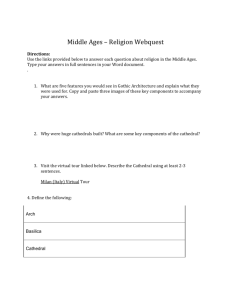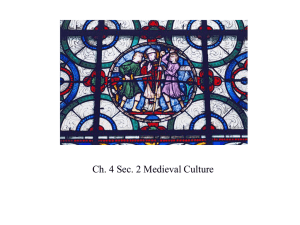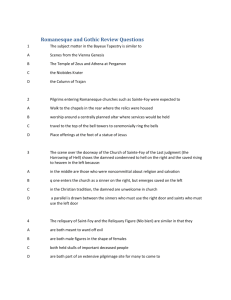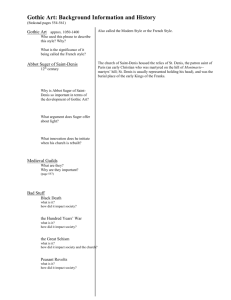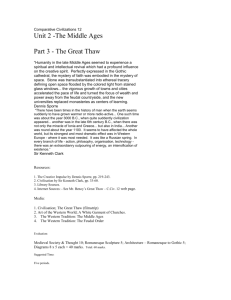Syllabus (Word) - Department of Art History
advertisement
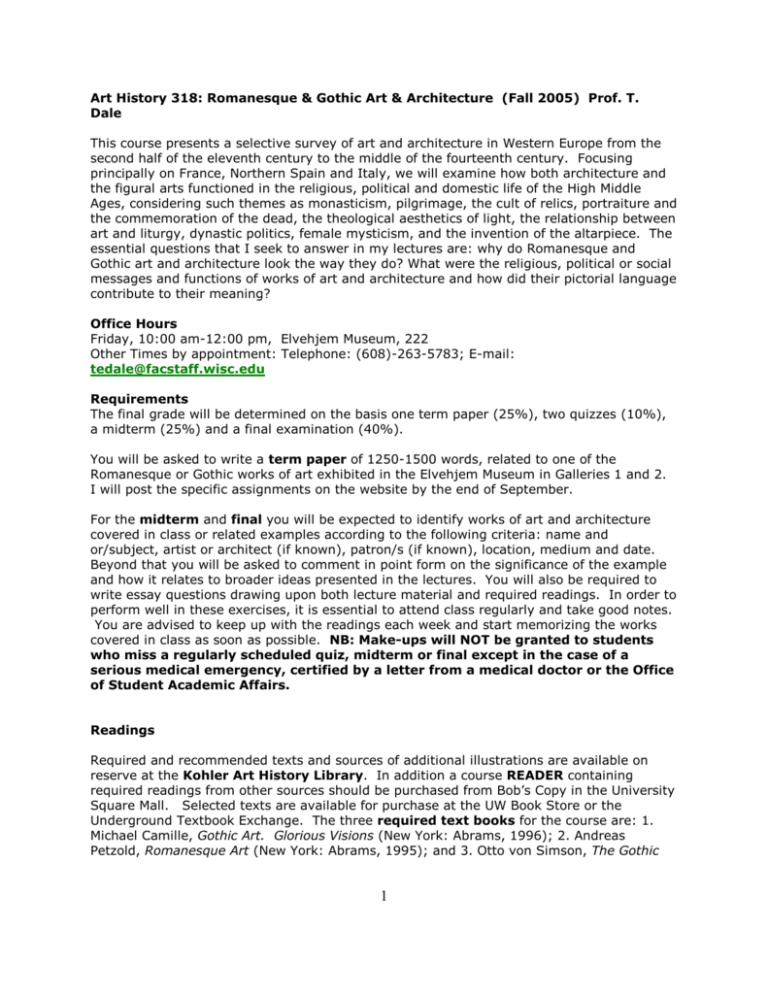
Art History 318: Romanesque & Gothic Art & Architecture (Fall 2005) Prof. T. Dale This course presents a selective survey of art and architecture in Western Europe from the second half of the eleventh century to the middle of the fourteenth century. Focusing principally on France, Northern Spain and Italy, we will examine how both architecture and the figural arts functioned in the religious, political and domestic life of the High Middle Ages, considering such themes as monasticism, pilgrimage, the cult of relics, portraiture and the commemoration of the dead, the theological aesthetics of light, the relationship between art and liturgy, dynastic politics, female mysticism, and the invention of the altarpiece. The essential questions that I seek to answer in my lectures are: why do Romanesque and Gothic art and architecture look the way they do? What were the religious, political or social messages and functions of works of art and architecture and how did their pictorial language contribute to their meaning? Office Hours Friday, 10:00 am-12:00 pm, Elvehjem Museum, 222 Other Times by appointment: Telephone: (608)-263-5783; E-mail: tedale@facstaff.wisc.edu Requirements The final grade will be determined on the basis one term paper (25%), two quizzes (10%), a midterm (25%) and a final examination (40%). You will be asked to write a term paper of 1250-1500 words, related to one of the Romanesque or Gothic works of art exhibited in the Elvehjem Museum in Galleries 1 and 2. I will post the specific assignments on the website by the end of September. For the midterm and final you will be expected to identify works of art and architecture covered in class or related examples according to the following criteria: name and or/subject, artist or architect (if known), patron/s (if known), location, medium and date. Beyond that you will be asked to comment in point form on the significance of the example and how it relates to broader ideas presented in the lectures. You will also be required to write essay questions drawing upon both lecture material and required readings. In order to perform well in these exercises, it is essential to attend class regularly and take good notes. You are advised to keep up with the readings each week and start memorizing the works covered in class as soon as possible. NB: Make-ups will NOT be granted to students who miss a regularly scheduled quiz, midterm or final except in the case of a serious medical emergency, certified by a letter from a medical doctor or the Office of Student Academic Affairs. Readings Required and recommended texts and sources of additional illustrations are available on reserve at the Kohler Art History Library. In addition a course READER containing required readings from other sources should be purchased from Bob’s Copy in the University Square Mall. Selected texts are available for purchase at the UW Book Store or the Underground Textbook Exchange. The three required text books for the course are: 1. Michael Camille, Gothic Art. Glorious Visions (New York: Abrams, 1996); 2. Andreas Petzold, Romanesque Art (New York: Abrams, 1995); and 3. Otto von Simson, The Gothic 1 Cathedral (Princeton: Princeton University Press, 1989). The following recommended texts are also available for purchase: James Snyder, Medieval Art: Painting, Sculpture, Architecture, 4th-14th Century (New York: Abrams, 1988); Roger Stalley, Early Medieval Architecture (Oxford, 1999); Cecilia Davis-Weyer, Early Medieval Art, 300-1150 (Toronto, 1986); Teresa Frisch, Gothic Art, 1140-c1450 (Toronto, 1987) Images, Lecture Lists and Website A website is currently under construction for the course. It will include a printable syllabus for the entire course and most of the essential images discussed in lectures. It can be accessed from the Department Homepage at http://www.wisc.edu/arth/materials.html . In addition, I will e-mail to you prior to each lecture a complete lecture list identifying the specific monuments or works of art, terms and historical facts presented in class. Fourth-Credit students will be required to meet with me for discussion of readings and short presentations focusing on an independent research topic to be developed in the course of the semester. We will meet on selected Wednesday afternoons, 5-6:30 pm in LVM120. I also plan to take an obligatory field trip to look at medieval art in the Art Institute of Chicago on Saturday Nov. 16. Please note that the fourth-credit meetings are not review sessions and are intended primarily for highly motivated art history majors. Sept. 3 I. Introduction: DEFINITIONS Readings: Petzold, Romanesque Art, 7-23; Camille, Gothic Art, 9-25. What are the origins of the terms “Romanesque” and “Gothic”? What are the standard formal definitions of Romanesque and Gothic? Why are these definitions unsatisfactory? How do both Petzold and Camille seek to redefine these two periods? Sept. 5 II. Romanesque Architecture of the Pilgrimage Roads Readings: “Pilgrims’ Guide to Santiago de Compostela” in Davis-Weyer, Early Medieval Art, 147-56; Petzold, 115-21; Stalley, Early Medieval Architecture, 147-155 What motivated the pilgrimage to Santiago de Compostela? What religious and political factors were involved in the orchestration of the cult of Saint James? What does the pilgrims’ guide emphasize in its description of Santiago? How does the architecture of Santiago relate to that of other major pilgrimage churches in France? How does the architectural planning facillitate pilgrimage and other functions of each church? What alternative schemes are deployed for pilgrimage churches elsewhere in Italy and France? Sept. 10 III. Cistercians and Cluniacs: Romanesque Art & Architecture of the Monastic Orders Petzold, 100-114; Stalley, 167-189. Benedictine Rule, excerpts in Medieval Source Book 2 on-line at http://www.fordham.edu/halsall/source/rul-benedict.html . What are the essential tenets of the monastic life as outlined in the Benedictine Rule? How is monastic architecture designed to enhance symbolic and functional distinctions between individual parts of the monastic complex? What are the differences bewteen Cistercian from Cluniac monasticism and how are these differences manifested in the art and architecture of the two orders? Sept. 12, 17 IV. Revelation, Judgement and Spiritual Passage in the French Romanesque Portal (Moissac and Vézelay; Autun and Conques) M. F. Hearn, Romanesque Sculpture, 102-17; 169-91. Linda Seidel, “The Moissac Portal and the Rhetoric of Appropriation?” in READER. What are the essential features of the canonical French Romaneque portals according to Hearn? What is the significance of the iconography (subject matter) for its location at the threshold of the church? What role do pictorial structure (composition and narrative disposition) and inscriptions play in the “reading” of the visual imagery? How does Seidel depart from conventional characterizations of the portal of Moissac? How does the framework of the porch condition the viewer’s response to the sculptural program as a whole? How does it ultimately reinforce the assimilation of the viewer’s entry into the church building with both the biblical journeys and the viewer’s own reception into the Heavenly Jerusalem at the end of time? Sept. 19 V. Monstrosity, Corporeal Deformity and Fantasy in Romanesque Art Bernard of Clairvaux, Apologia to William of St. Thierry in Davis-Weyer, Early Medieval Art, 168-170; Schapiro, "On the Aesthetic Attitude in Romanesque Art," (1947) in Romanesque Art (New York, 1977/1993), 1-27 and READER; T. Dale, “Monsters, Corporeal Deformities, and Phantasms in the Cloister of St-Michel-de-Cuxa,” Art Bulletin 83, no. 3 (2001):402-436 (available both in photocopy on Reserve and in full-text version at http://wilsontxt.hwwilson.com/pdffull/04407/1Z7G6/3SX.pdf ) What are the origins of the term “fantasy” (phantasy) and how does its medieval meaning differ from most current definitions? What is the etymology of the term “monster” and how was it understood by medieval writers? What is Bernard of Clairvaux’s attitude towards art in general and the representation of monsters and other human and animal subjects in cloister capitals, in particular? How does Schapiro reinterpret Bernard’s complaint in terms of artistic creation? How does my own interpretation differ from Schapiro’s? What issues concerning these images are still left unresolved? Sept. 24 VI. Eve, Salome and Mary: Defining the Role of Women in Romanesque Art Petzold, 123-129; Linda Seidel, “Salome and the Canons,” Women’s Studies 11 (1984):2966 in READER. What are the prescribed positive and negative roles for women in medieval Christian theology and how are they manifested in Romanesque art? What is the significance of 3 nudity and corporeal posture in the figure of Eve at Autun? What is the significance of Salome in the context of the Toulouse capital depicting the Feast of Herod? According to Seidel, how would this figure have been understood by the intended audience of canons at the cathedral and how was the narrative represented in a different fashion for the monks of La Daurade? Sept. 26 VII. Glorified Bodies: Romanesque Cult Images, Saints and Tomb Portraits H. Belting, “Statues, Vessels, and Signs: Medieval Images and Relics in the West,” in Likeness and Presence, 297-310 and in READER; T. Dale, “Rudolf von Schwaben, the Individual, and the Resurrected Body in Romanesque Portraiture,” Speculum 77, no. 3 (2002):707-743 in READER. How did the Western church come to accept sculptural images of the Virgin Mary and the saints, in spite of traditional fears of idolatry? What explains the different approach to Holy Images in Byzantium and the West? What is the siginificance of the form, material of these images? To what extent can they be considered to be “portraits”? How do the cult images of the saints in metalwork suggest an analogy for funerary effigies like that of Rudolf von Schwaben? How are the theology of resurrection and the special dual status of the royal body reflected in the form and medium of the effigy? Oct. 1 VIII. The Warrior Class: Knighthood, Holy Warfare and Crusade Petzold, 71-85; Staley, 83-101. What was the political and religious function of the knight in medieval society? How did the knight gain a special, sanctified status during the Crusades? What allegorical roles did images of the knight fulfill in Romanesque art? How do the chansons de geste and narratives such as that on the Bayeux tapestry represent feudal, political and religious values? What were the basic design features of castles in the eleventh to thirteenth centuries and what symbolic values were embodied in their exterior appearance? Oct. 3, 8 (QUIZ I on Oct. 3: covers lectures I-VII) IX. Reform, Renovatio, Ritual and Antiquarianism: Rome and South Italy in the Eleventh and Twelfth Centuries Leo of Ostia, Chronicle of Montecassino in Davis-Weyer, Early Medieval Art, 135-40, 156-62; R. Krautheimer, Rome: Profile of a City (Princeton, 2000), 161-202; E. Kitzinger, “A Virgin’s Face: Antiquarianism in Twelfth-Century Art,” Art Bulletin 62.1 (1980):6-19 in READER. Additional Illustrations: Snyder, 313-33; Demus, Romanesque Mural Painting, plates 18-37. What were the impetus and sources for the artistic revival that took place at Montecassino during the second half of the half of the eleventh century? What role did Montecassino play in the artistic revival in Rome after 1100? What were the ecclesiastical and political motives for the Gregorian reform and the subsequent artistic programs in Rome and what role did individual patrons play? Why does Rome constitute a special case of antiquarianism? How is ancient art re-interpreted by medieval viewers? How is the urban space of Rome Christianised by the ritual of Assumption Day? How does the apse mosaic of Santa Maria in Trastevere re-present the ritual in concrete form and what is the meaning of the 4 antiquarianism of its iconography? What was particiularly innovative about the theme of this apse? Oct. 10 X. Romanesque Art and Architecture and Civic Pride in Tuscany and North Italy Snyder, 320-33; Petzold, 50-51; Hearn, Romanesque Sculpture, 155-63. How does Romanesque architecture in Tuscany and North Italy differ from that of France studied thus far? How does the disposition of monumental stone sculpture depart from the French model? How are the roles of civic patron and artist highlighted? Oct. 15 XI. "Multiculturalism" in Twelfth-century Norman Sicily Petzold, 85-92, 146-155; W. Tronzo, "The Medieval Object Enigma and the problem of the Cappella Palatina,” READER What specific historical circumstances led the Normans to appropriate the artistic forms and iconography of other Islamic and Byzantine cultures in their royal art and architecture? How are Islamic forms used differently in other contexts described by Petzold? How does Tronzo use ritual to explain the unusual combination of distinctive traditions in the Cappella Palatina in Palermo? How is the “Byzantine” decoration of the sanctuary adapted for the Norman ruler’s view point? What was the apparent function of the western “nave” space of the chapel? Oct. 17 XII. San Marco in Venice Dale, “Stolen Property: St. Mark’s First Venetian Tomb and the Politics of Communal Memory,” READER. For additional illustrations: Otto Demus, The Mosaics of San Marco in Venice , 4 volumes (Chicago, 1984). What motivated the Venetian theft of the relics of Saint Mark from Alexandria? How do the architectural form and mosaic decoration of San Marco adapt Byzantine prototypes and why? How and why did the Venetians update their sacred narrative history around the focal point of Mark’s first Venetian tomb? How was San Marco transformed in the wake of the Fourth Crusade? Oct. 22: MIDTERM (covers lectures and readings I-XI) Oct. 24 XIII. Ornamenta Ecclesiae: Romanesque and Gothic Metalwork in service of the Liturgy Theophilus, Treatise on Divers Arts in Davis-Weyer, Early Medieval Art,176-178; Petzold, 61-66; R. Calkins, “Metalwork of the Church Treasuries,” in Monuments of Medieval Art (New York, 1979),115-132 in READER. What is the role of the craftsman/artist according the Theophilus’s treatise on Divers Arts? Why did medieval metalworkers acquire a particularly elevated status as artists? What is the 5 meaning of material radiance and how would Theophilus justify such expense in the wake of criticisms from ascetic minded clerics such as Bernard of Clairvaux? What were the different techniques were developed in the twelfth and thirteenth centuries? How does the iconography of individual objects reinforce or explain their functions? What is the meaning of “typological” interpretation and what does it suggest about the medieval Christian perception of Judaism? Oct. 29 XIV. Innovation and Antiquarianism: Abbot Suger and the Origins of the Gothic Suger, On the Abbey Church of Saint-Denis & its Treasures in T. G. Frisch, Gothic Art, 1140ca 1450 (Toronto, 1987), 4-13; Von Simson, The Gothic Cathedral, 3-20; 21-58; Fernie, “Suger’s Completion of Saint-Denis” in READER. Rec. and additional illustrations: Bony, French Gothic Architecture, 79-98. What were Abbot Suger’s motivations for the rebuilding of the west facade and choir of the abbey of Saint-Denis? What are the roles as patron that Suger projects in his narrative account of the new building campaign? What was innovative about the structure and form of his additions to the abbey church and its treasury? What theological, political and personal factors explain Suger’s new architecture? To what extent does Suger respond to the complaints voiced by Bernard of Clairvaux, his contemporary? How, according to Fernie, did the new choir also build upon and deliberately integrate elements of earlier architectural practice in general and the pre-existing fabric of St. Denis itself? How is his reverence and aesthetic appreciation for the past reflected in the objects of his refurbished treasury? Oct. 31 XV. The Gothic Architectural Revolution in the Ile de France, ca. 1150-1260: Mysticism & Technology, Epsicopal and Royal Pride Camille, 27-40; Stephen Murray, Notre-Dame, Cathedral of Amiens (New York, 1996), 1-16; Beat Brenk, “The Sainte Chapelle as Capetian Political Program” in READER. For images and video of Amiens see http://www.learn.columbia.edu/Mcahweb/index-frame.html. How were the components of the elevation and the formal vocabulary of French Gothic architecture transformed in the course of the late twelfth and early thirtheenth centuries? What different factors (politics, theology, technology, visuality) explain the revolutionary change and rapid diffusion of the Gothic style in architecture? How does Camille transcend the notion of formal development or evolution of form with his theory of visuality? What new model does Murray propose for understanding the design process at Amiens Cathedral? How did the cathedral chapters pay for their vast new cathedrals and what social tensions surrounded their construction? What was the function of the Sainte Chapelle and how did it serve to reinforce royal authority? Nov. 5-7 XVI. Chartres Cathedral, High Gothic Architecture, Stained Glass and Sculpture Von Simson, The Gothic Cathedral, 91-141. Williamson, Gothic Sculpture, 1140-1300. (New Haven, 1995), 11-21, 37-48; J. Welch Williams, Bread, Wine, and Money. The Windows of the Trades at Chartres Cathedral (Chicago, 1993), 3-18 in READER. 6 Where does the architecture of Chartres Cathedral fit in the formal development of Gothic? How is the cult of the Virgin Mary as principal titular saint of the cathedral constantly reinforced in the overall programme of decoration–both in sculpture and stained glass? What formal and iconographic changes are witnessed in the sculpture and stained glass of the cathedral from the twelfth and thirteenth centuries (contrast Chartres West and the transept portals)? To what extent do the form and iconography of sculpture and stained glass suggest fundamental theological and political ideas? How was the rebuilding of the cathedral financed, what role did different social groups play and how are they represented in the stained glass program? How does Williams counter traditional interpretations of the trades windows at Chartres as images of pious donation? What underlying social and economic tensions existed in thirteenth-century Chartres? How do images of tradesmen help consolidate clerical authority? Nov. 12 XVII. English Gothic Architecture and Visuality. Gervase of Canterbury, Treatise on the Fire and Repairs to the Cathedral of Canterbury, excerpt in Frisch, Gothic Art, 15-23; Snyder, Medieval Art, 402-414. What were the circumstances that led to the introduction of Gothic architecture at Canterbury? What does Gervase suggest about the relationship between the cathedral and the citizens of the town? What valuable information does he provide both about the building process and the medieval perception of stylistic difference? How does English Gothic architecture depart from the French paradigm (in terms of elevation, ground-plan, facade design, vaulting etc) as represented by Amiens and Chartres? How can these differences be explained? What pictorial values are incorporated into English Gothic architecture? Nov. 14 XVIII. Naturalism and Expressionism in Thirteenth Century Gothic Sculpture of Northern Europe. Camille, 133-161. What formal changes can be witnessed in later medieval art from the thirteenth to fifteenth centuries? What historical, theological and social factors explain late medieval “naturalism” and expressionism? Nov. 19 XIX. Mysticial Visions and Devotional Images in Northern Gothic Art, ca. 12901450 Camille, Gothic Art, 103-131; J. Hamburger, "The Visual and the Visionary: The Image in Late Medieval Monastic Devotions," Viator 20 (1989):161-82 in READER. What is a devotional image? How do later Gothic mystical visions and devotional images depart from biblically based images? What roles did nuns and their male supervisors play in the creation of a distinctive tradition of devotional art? What gender biases led visionary images to be associated primarily with women? Nov. 21 (QUIZ II: covers lectures XII-XVIII) XX. Courtly Love and Profane Pleasures in Fourteenth-Century France 7 Camille, Gothic Art, 167-73; R. Randall, "Popular Romances Carved in Ivory," in P. Barnet, ed. Images in Ivory (Detroit, 1997), 63-79, illustrations, 218-248. Rec. Camille, The Medieval Art of Love, 51-71 What are the principal literary sources of images of courtly love in French Gothic art? What different metaphors are used to describe courtship and how do they reflect mysoginistic tendencies in medieval society? What iconographic signs gestures constitute the pictorial language of courtly love? How does this kind of imagery relate to the function of the objects it adorns? To what extent do these themes of profane love make reference to sacred art (in style or iconography)? Nov. 26 XXI. Gothic Art and Architecture and the Rise of the Mendicant Orders in Italy Pseudo-Bonaventure, Meditations on the Life of Christ, excerpt in READER; J. White, Art and Architecture in Italy, 1250-1400 (Harmondsworth, 1988), 21-44; 74-92. M. Trachtenberg, "Gothic/Italian Gothic: toward a redefinition" Journal of the Society of Architectural Historians 50 (1991):22-37 in READER. Who was Saint Francis and what was revolutionary about the new order that he founded? How does Italian Gothic architecture depart from the French paradigm and what local factors explain its apparent conservatisim? How does Trachtenburg redefine Italian Gothic in more positive terms vis-à-vis French models? How does Trachtenburg suggest that Italian Gothic can be considered a departure from both earlier “historicist” Romanesque architecture in Italy and contemporary “modern” Gothic in France. What role did the rise of the mendicant orders play in the dissemination of Gothic architecture in Italy and how was the architectural planning adapted to the needs of these new orders? What different sources of insipiration are synthesized in Italian Gothic sculpture? How is mendicant spirituality reflected in the sculpture of the Pisani? How did devotional texts such as the Pseudo-Bonaventure’s Meditations foster new attitudes in the pictorial representation of the life of Christ? Nov. 28: THANKSGIVING HOLIDAY Dec. 3 XXII. Icon to Altarpiece: The Maniera Greca and Italian Painting around 1300. Frisch, Gothic Art, 85-88; W. Tronzo, “Between Icon and Monumental Decoration of a Church: Notes on Duccio’s Maestà and the Definition of the Altarpiece,” in READER. Rec: Belting, Likeness and Presence, 377-408. What role did the “maniera greca” (Byzantine art) play in the orgins of the altarpiece? How did Italian masters adapt Byzantine style and iconography for the altarpiece? What specific new functions did the altarpiece perform? What was particularly remarkable about Duccio’s Maiestà? What does the contract for the Maiestà tell us about the relationship bewteen artist and patron? What was the civic role of the new altarpiece? Dec. 5 XXIII. Secular Architecture and City Planning in the later Middle Ages 8 Camille, Gothic Art, 57-68; Rec. Calkins, Monuments of Medieval Art, 254-64 How was the space of medieval city or town organized? What were the principal focuses of public space in the city? How were political and ecclesiastical power highlighted within the city? To what extent did the city and its walls encorporate symbolic values? What are the principle features of domestic architecture and to what extent did noble families draw on earlier castle architecture? Dec. 10 XXIV. The “Waning of the Middle Ages”: Personalised visions of the afterlife, the Grotesque and the Macabre Camille, 151-161; Paul Binski, Medieval Death (Ithaca, 1996), 123-63 in READER Why has it often been assumed that medieval art in the late fourteenth and early fifteenth centuries was in a state of decline? What new explanations are offered by Camille and Binski? Why was medieval art in its last phase so preoccupied with death and the macabre? What new functions did art fulfill in the preparation of the individual for death and resurrection? Dec. 12 Conclusions and Review E. Panofsky, Renaissance and Renascences in Western Art (New York, 1960), ch. 3: 114161. What distinguishes the Renaissance of the fifteenth century from the earlier revivals of ancient art and culture in the Middle Ages? What are the problems with establishing strict chronological boundaries between Renaissance and Medieval? To what extent do medieval functions of religious art continue into the Renaissance? Dec. 17 (Tuesday) FINAL EXAM, Elvehjem L150, 2:45-4:45 pm. 9

